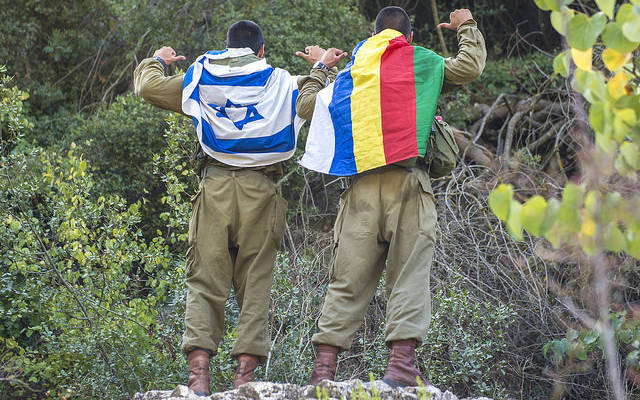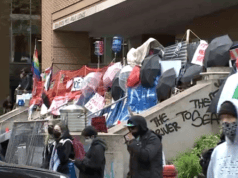.By Rachel Avraham
In the 1500’s, the Druze had great influence in the Land of Israel. By virtue of the help given to Sultan Salim I and the Sultan’s desire to acknowledge Druze support, Fakh al Din I was awarded the Emirate of the Druze. His son Qorqomas extended his rule over Tyre, Acre, and Caesarea, and a territory that included most of the Galilee. This aroused the anger of Ibrahim Pasha, the governor of Egypt, who turned against him and ended Qorqomas’ rule in 1585.
“A year later, Qorqomas was succeeded by his son Fakhr Al Din II, the most renowned Amir of the Manid dynasty. During the period between 1603 and 1607, he ruled all southern Lebanon and a large part of Israel. The entire region between Beirut and Caesarea, the sources of the Jordan, the Huleh, Safed, Tiberius, Nazareth, and Mount Tabor came under his control. For a short time, the Amir and his ally Junblat also ruled southern Israel and part of Jordan and Gaza. The Druze Amir’s rule over Northern Israel continued about one hundred and fifty years until the end of the seventeenth century.”
According to Ayoob Kara, a prominent member of the Druze community, the Druze of Israel suffered greatly under Ottoman Turkish rule: “There were hundreds of villages under Druze autonomy from Ashkelon to Lebanon, from the south till the north, villages and villages of Druze that the Ottoman Turks destroyed. You can only find 150,000 Druze people in Israel today. They are in the Carmel and Galilee Mountains and the Golan Heights. You cannot find Druze in Southern Israel anymore. The Ottoman Turks ethnically cleansed the Druze from the other areas. They hated the Druze and considered them to be no better than how many extremist Muslims view Jews today. However, most Druze are afraid to talk about that.”
Dr. Salman Falah, author of The Druze in the Middle East, was not shy to write about it, though, and he noted: “The destruction did not happen in a methodological and planned way, but rather occurred over the course of generations because of the persecution and hate of their Muslim neighbors. The first known destruction of a Druze village was in the seventeenth century. When the Zaydan family settled in the Nablus district, it exterminated the Druze north of the Nablus district, centering in the village of Salama. Almost all the sources agree that the destruction of the greatest number of villages occurred during the Egyptian conquest under the rule of Ibrahim Pasha by the conquering army and by neighboring Muslims after Egypt’s retreat.
The region that suffered more than the others from this conquest and the retreat of the conquerors was that of Mount Carmel. After the retreat of Manid rule and the loss of their control of Northern Israel, the Muslim residents and the succeeding governments took revenge on the Druze, who were members of the same community as the former rulers.” As a result of such persecution, the Druze historically have taken refuge in the mountains of Syria, Lebanon, and Israel, as they form a protective geographic barrier against hostile forces.
Considering this history, most Druze were not hostile towards the early Zionists and the subsequent establishment of the State of Israel. As Dr. Randall Geller, a scholar at Brandeis University, noted in his book entitled Minorities in the Israeli Military, 1948-1953: “Although the Druze were only a miniscule part of the Arab population, other than a few isolated cases, the Druze maintained communal neutrality throughout the Arab riots of 1929, the Arab Revolt of 1936-1939 and in the War of 1947-8. Some even joined the IDF and fought on Israel’s side during the 1948 war.”
The fact that the Druze are known to be excellent warriors convinced early Zionist leaders of the utmost importance of cultivating a friendship with the Druze community. In 1907, Yitzhak Epstein wrote, “The Druze tribe, the mightiest of the Arab tribes, is known for its courage, its heroism, its physical strength. It is hated by the other Arabs and by the government, but its courage has prevailed.”
A 1942 Haganah report concurred: “The Druze are men of war.” Ben Dunkelman, a Canadian Jewish volunteer who fought in Israel’s War of Independence, added: “The Druze’s centuries long survival as a minority has given the Druze two seemingly contradictory traits: conformism and belligerency. They have a reputation for allying themselves with whatever force is ascendant, yet at the same time, they are superb and tenacious warriors.”
Aharon Chaim Cohen, who went on a Jewish Agency fact-finding mission during the British Mandate period, found that the Druze also were greatly interested in forming a friendship with the early Zionists, for they wished to “maintain communal independence” and believed that Zionist control would respect this wish the best: “During my time in the Druze villages, I became aware that they want an alliance with us. In every village that I went and especially in the villages where all the residents are Druze, I heard of their will to become closer to us.”
Since the Druze were either neutral or allied with the Jews during the British Mandate period,Cohen wrote, “the Abu Durra and other rebel bands attacked Druze villagers in retaliation, focusing on the Carmel villages of Ussafiya and Daliyat al-Carmel. These attacks had a devastating impact on the Druze community in Israel.
Rafik Halabi, a Druze journalist from Daliyat al-Carmel, wrote: “My own family sided with the Jews and my father made no secret of his position. Until 1948, however, supporting the Haganah meant provoking the wrath of the Muslims in the area and the consequences were usually brutal: raids, looting, abuse, and the theft of goats and sheep were a daily occurrence. Abu Dura, the leader of the armed Arab gangs in the thirties, attacked Jewish settlements and transportation, while also casting his terror over the Druze in the area as well. The Druze living on Mount Carmel nevertheless became allies of the Jews.’”
“In November 1938, Muslim rebels killed a number of Druze in Usafiya and desecrated Druze holy books,” Geller wrote. “Druze were attacked in Abu Snan, Yarka and Yanuh. Abu Durra’s gang also perpetrated attacks and desecrated Druze holy books in Daliyat al-Carmel.”
According to Halabi, “By the time the Druze of Carmel came to the point of refusing to contribute any funds to the insurgent Arabs, their dissociation has turned into a deep enmity.”
Geller emphasized the effects of this. “Muslim attacks, combined with Jewish cultivation of Druze neutrality, had a number of lasting effects: it accelerated the erosion of Druze faith in their chances of living peacefully under a Muslim authority in any future Arab state. The Druze who had thought of supporting the Arab side either became neutral or actively supported the Zionists.
“Only a small minority continued to support the Muslims in the face of violence perpetrated on the Druze community. Some Druze, particularly the sons of the murdered patriarchs of the Abu Rukun and Khneifes families, became the Zionists’ most ardent supporters and faithful allies in the years ahead. They would emerge as leaders in forging a Druze-Jewish alliance that began to blossom during Israel’s War of Independence.”
As former Israeli Defense Minister Moshe Arens wrote in his book In Defense of Israel, “I have always been impressed by the loyalty of the Druze community in Israel to the State of Israel, and by the service of their sons in the IDF. Among Israel’s minorities, the Druze and Circassian men are called up for compulsory military service, unlike the Muslim and Christian Arab young men. I instructed the High Command to allow Druze soldiers to choose among all branches of the IDF, instead of obliging them to serve in the Minority Battalion. That has been the IDF policy ever since. Gradually, the number of Druze who preferred service in the other battalions grew. The Druze battalion was disbanded in 2015. Today, Druze soldiers can be found serving in all branches in the IDF, and Druze officers have reached its highest ranks.”
This is Part 2 of a 3-part series on the history of the Druze and and the Jews of Israel. See Part 1 here.
Sources:
Ayoob Kara, MK – IsraeliAmerican.org
What Do the Druze Think of Zionism? – IsraelToday.co.il
Amazon.com: Minorities in the Israeli Military, 1948–58 eBook : Geller, Randall S.– Amazon.com
The Druze in the Middle East: Falah, Salman: 9780967026909 – Amazon.com
Halabi, The West Bank Story – MERIP.org
 Rachel Avraham is a political analyst working for the Safadi Center for International Diplomacy, Research, Public Relations and Human Rights, which is run by Mendi Safadi, a former Likud Candidate for the Knesset and a former chief of staff of former Israeli Communication Minister Ayoob Kara. Since 2012, she has been working as an Israel-based journalist and writer, covering Iran, Kurdistan, Turkey, Iraq, Syria, the Israeli-Palestinian conflict and other developments in the greater Islamic world.
Rachel Avraham is a political analyst working for the Safadi Center for International Diplomacy, Research, Public Relations and Human Rights, which is run by Mendi Safadi, a former Likud Candidate for the Knesset and a former chief of staff of former Israeli Communication Minister Ayoob Kara. Since 2012, she has been working as an Israel-based journalist and writer, covering Iran, Kurdistan, Turkey, Iraq, Syria, the Israeli-Palestinian conflict and other developments in the greater Islamic world.
Her articles have appeared in the Washington Times, the Hill, Front Page Magazine, the Daily Wire, the Christian Post, the Baltimore Jewish Times, the Jerusalem Post, Israel Hayom, Ahval and many other publications across the globe. She received her MA in Middle Eastern Studies from Ben-Gurion University. She got her BA in Government and Politics with minors in Jewish Studies and Middle Eastern Studies from the University of Maryland at College Park.
Ken`s new book The Multifront War is now available in 190 countries via Amazon and also on BNs in the US. Buy it now!
.
.
.






